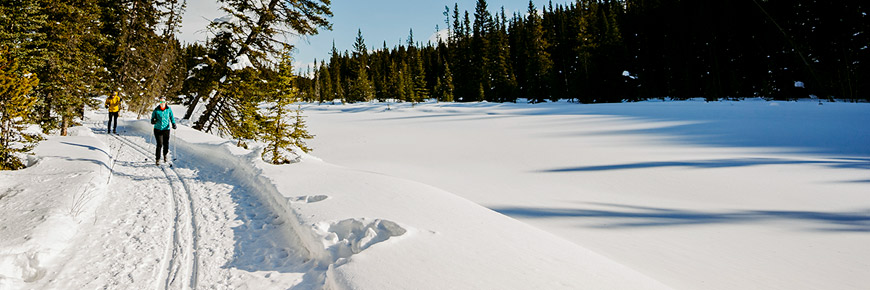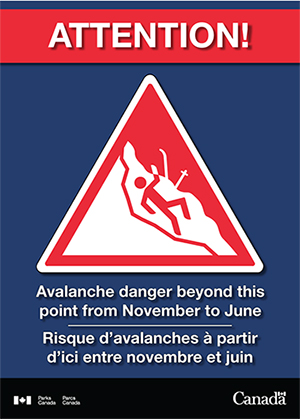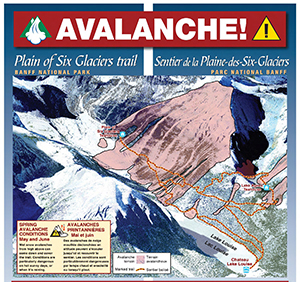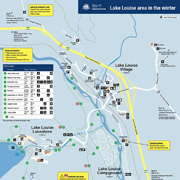
Recommended cross-country ski trails in the Lake Louise area
Banff National Park
Note: Not all sign-posted summer destinations are safe for winter travel. If you plan to travel beyond the designated winter destinations described below, your group should be prepared with the appropriate knowledge, skills and equipment.
Winter safety
Safety is your responsibility. There are always hazards associated with outdoor recreation. Even short trips can have serious consequences.
- Ask for advice at a Parks Canada Visitor Centre for help with trip planning.
- Check current trail conditions, warnings and closures.
- Study descriptions and maps before heading out. Always choose a trail suitable for the least experienced member in your group.
- Tell somebody where you are going, when you will be back and who to call if you do not return.
- Expect that trail conditions and winter hazards may change throughout the day. Consult weather forecasts and be prepared for changing weather and emergencies.
- Winter hazards include avalanches, disorientation, thin ice, hypothermia and frostbite.
- From November to March, make sure your car is winterized. Snow tires, proper clothing, and an emergency kit are recommended. Visit 511.alberta.ca for road reports.
- In case of EMERGENCY, call 911 or satellite phone: 403-762-4506. Cell phone coverage is not reliable throughout the national park.
Recommended Packing List
- Trail guide and map: guidebooks and topographic maps are available at the Banff and Lake Louise visitor centres, and retail outlets in Banff and Lake Louise.
- Full water bottle or thermos
- High energy food
- Bear spray
- First aid kit and repair kit
- Lightweight emergency blanket, candle and lighter or waterproof matches
- Headlamp or flashlight with spare batteries
- Toque or winter hat and gloves
- Sunscreen and sunglasses
- Hand and toe warmers
- Extra warm clothing in case of an emergency
- Cell phone or satellite communication device
Visit parksmountainsafety.ca for additional information on winter packing.
Wildlife
Although bears are denning during the winter, they can awaken at any time for short periods. Cougars, wolves and other wildlife remain active throughout the year. If you see wildlife, do not approach; give them lots of space and observe from a distance with binoculars or a telephoto lens. If tracks are observed, do not follow them towards the animal.
Be alert, make noise and carry bear spray. Learn more about keeping yourself safe.
 Avalanche safety at Lake Louise
Avalanche safety at Lake Louise
Avalanche season in the mountains extends from November to June, and even a short walk can take you into avalanche terrain. Trails with a known hazard are identified with an avalanche symbol. When travelling beyond marked trails, or past an avalanche danger sign, assume you are in avalanche country – never enter avalanche terrain without a beacon, probe, shovel and avalanche training.
Check the current avalanche forecast at a Parks Canada Visitor Centre or avalanche.ca

Stop here
If you see this sign, you are about to enter avalanche terrain.
Avalanches are possible from November until June and you could be buried or injured.
Do not proceed unless you have avalanche training and a transceiver, probe and shovel.
There are often tracks beyond these signs left by equipped parties – this does not indicate that the trail is safe. You don’t know how informed previous travellers were or what the conditions may have been at the time.
Your safety is your responsibility.
Avalanche zones at Lake Louise
Mount Fairview

Left side of Lake Louise
November to June annually
Watch for this avalanche zone on Mt. Fairview on the left side of Lake Louise past the boat house. It may also be accessed beyond the Fairview Lookout.
This is an impressive natural feature but please enjoy it from afar.
For your safety and the safety of others, do not stand under this slide path or walk across it. Keep in mind that tracks left by others do not mean that the area is safe.
Teahouse trails

Plain of Six Glaciers and Lake Agnes including Mirror Lake
November to June annually
These very popular summer hikes are not safe for travel in the winter unless you have avalanche training and equipment.
The avalanche zones on both trails are clearly marked. Keep in mind that tracks left by others do not mean that the trail is safe.
Note: The teahouses are closed in winter. When trails begin to clear in May check the trail report for current conditions. Your safety is your responsibility.
Saddleback Pass
Trail to Saddleback Pass
November to June annually
This trail climbs the southeast flank of Mount Fairview and crosses a prominent avalanche slide path along the way. The avalanche zone is clearly marked. Do not enter it without avalanche training and equipment.
Keep in mind that tracks left by others do not mean that the trail is safe. You don’t know how informed previous travellers were or what the conditions may have been at the time. Your safety is your responsibility.
Louise Falls

Visible from the Lake Louise Lakeshore trail at the back of the lake.
The waterfall freezes in the winter and is a popular ice climbing destination.
Enjoy the view but please avoid standing directly under Louise Falls, especially in the spring. Falling ice can be a hazard at this location.
Learn how to travel safely in avalanche country
Many excellent programs exist to help you learn to travel safely in avalanche country. Visit Avalanche Canada for a list of programs and an online introductory primer.
Visit parksmountainsafety.ca for more information on backcountry travel and how to stay safe in the mountains.
Get outside, have fun and be safe!
Trail etiquette
Trails are shared in the national park, which means you could see people fat biking while you are winter hiking, or people skiing while you are snowshoeing.
- The track set portion of the trail is for classic skiing only. The flat, groomed lane is for other users.
- When climbing, please yield the right of way to descending skiers and fat bikers.
- If you fall, move off the track as quickly as possible.
- When taking a break, step to the side, leaving room for others to pass.
- Leave no trace. Pack out everything you pack in.
- Read the trail descriptions as dogs are not permitted on certain trails. Keep dogs on leash and under physical control at all times.
Trail ratings
|
Easy |
|
|
Moderate |
|
|
Difficult |
|
| For all trails, be prepared as conditions can change quickly; easy and moderate trails can become difficult due to weather change, icy conditions or poor visibility. | |
| Trail | Distance | Activity recommended |
|---|---|---|
| 15.6 km return | ||
| 4.6 km one way | ||
| 4.8 km one way | ||
| 4.1 km loop | ||
| 1.4 km one way | ||
| 20 km return | ||
| 2.2 km one way | ||
| 4 km one way | ||
| 6.6 km or shorter versions of the loop |  |
|
| 2.2 km outer loop | ||
| 0.7 km one way | ||
| 13.3 km loop | ||
| 3 km one way | ||
| 2.7 km one way | ||
| 2.3 km one way | ||
| 3.5 km one way | ||
| 3.5 km one way | ||
| 8.7 km of trails |



Lake Louise area ski trails
 Moraine Lake Road
Moraine Lake Road
15.6 km return
250 m elevation gain
Double trackset with skating lane
![]()
![]()

Climbing steadily, this trail includes both gently rolling and hilly stretches. Tracksetting ends at a viewpoint of Consolation Valley and the Ten Peaks.
 Avalanche hazard: Beyond the viewpoint, the road crosses large avalanche paths. Travel beyond this point requires avalanche training and equipment.
Avalanche hazard: Beyond the viewpoint, the road crosses large avalanche paths. Travel beyond this point requires avalanche training and equipment.

 Fairview
Fairview
4.6 km one way
60 m elevation gain
Single trackset
![]()

A beautiful trail, the Fairview runs through sections of open clearings and snow-draped woods. It’s also possible to make a 7.5 km loop (160 m total elevation gain) using the Fairview trail, the Moraine Lake Road and the Tramline trail: the recommended direction is counter-clockwise.
 Tramline
Tramline
4.8 km one way
195 m elevation gain
Double trackset
![]()
![]()

This trail runs from valley bottom to Lake Louise at a steady 3% rise, following the old grade of the tramline that once connected the train station and the Chateau Lake Louise.

 Lake Louise Loop
Lake Louise Loop
4.1 km loop
15 m elevation gain
Double trackset
![]()
This loops features a wide open ski across frozen Lake Louise, followed by a fun “up & down” trip back through the woods – just 100 metres uphill from the lakeshore walking path. Use the Fairview – Lake Louise Connector trail to ski directly from the parking lot onto the lake.
 Avalanche hazard: Beyond the back of the lake, the trail crosses large avalanche paths. Winter travel to the Plain of Six Glaciers requires avalanche training and equipment.
Avalanche hazard: Beyond the back of the lake, the trail crosses large avalanche paths. Winter travel to the Plain of Six Glaciers requires avalanche training and equipment.


 Upper Telemark
Upper Telemark
1.4 km one way
65 m elevation loss
Double trackset
![]()

This trail has several steep and technically demanding hills. If you find them too imposing, they can be avoided by taking the “Hillside” bypass. Start in front of the Chateau Lake Louise as if going to Lake Agnes, then turn right onto trail #5. Once up and behind the Chateau, ski steeply down to the Great Divide and Lower Telemark trails.
 Great Divide or "Old 1A"
Great Divide or "Old 1A"
20 km return
60 m elevation loss
Double trackset with skating lane
![]()
![]()

Mostly flat, but trending gently downhill, this trail takes you to the “Great Divide” – the BC / Alberta border. From here, you can continue into Yoho another 3.5 km (grooming irregular) to the Lake O'Hara parking lot.

 Peyto
Peyto
2.2 km one way
45 m elevation loss
Double trackset
![]()

This trail has a tricky starting point, off the small access road to the Brewster Stables behind Deer Lodge, but it offers a more gentle downhill to the Great Divide and Lower Telemark trails than trail #5.
 Lower Telemark
Lower Telemark
4.0 km one way
110 m elevation loss
Double trackset
![]()

Park at Great Divide trailhead, ski 700 metres, and turn right at the #8 trail sign. After 4.0 km of twists and turns, exit back onto the Great Divide trail, and turn left to return to your vehicle.
 Bow River Loop
Bow River Loop
6.6 km or shorter versions of the loop
No elevation gain.
Single trackset
![]()
![]()

Mostly flat, following the river. To start, park near the Station Restaurant or just past the campground kiosk, or use the connecting trail from the Post Hotel or the Samson Mall.
 Campground Loop
Campground Loop
2.2 km outer loop
15 m elevation gain
Double trackset with skating lane
![]()
This trail loops around and through the campground on gentle terrain. For access, park just past the campground kiosk.
 Townsite
Townsite
0.7 km one way
No elevation gain
Double trackset
![]()
This short trail provides access to the northwest end of Village Road, near all the village hotels.
Pipestone ski trails
 Pipestone Loop
Pipestone Loop
13.3 km loop
190 m elevation gain
Single trackset
![]()
Watch for the occasional tight corner and be cautious on the hills. The recommended direction for the outer loop is counterclockwise.
 Hector
Hector
3.0 km one way
95 m elevation gain
Single trackset
![]()
This trail features good views at both a major fire protection clearing and tranquil Pipestone Pond.
 Drummond
Drummond
2.7 km one way
24 m elevation loss
Single trackset
![]()
If you need a breather, this is the only flat trail in the Pipestone trail system.
 Merlin
Merlin
2.3 km one way
55 m elevation gain
Single trackset
![]()
Watch for the old pioneer log cabins along this leg of the Pipestone.
Bow Valley Parkway #1A ski trails
 Baker Creek to Protection Mountain Campground
Baker Creek to Protection Mountain Campground
3.5 km one way
No elevation gain
Single trackset
![]()
This trail (labelled “#2" on-site) runs parallel to the parkway, and starts across the road from the Baker Creek Chalets.
 Protection Mountain Campground to Castle Mountain Lookout
Protection Mountain Campground to Castle Mountain Lookout
6.4 km on way
15 m elevation gain
Single trackset
![]()
This trail links the other two cross country ski trails on the Bow Valley Parkway. Travel this unique path to discover a new perspective on the original auto-route through Banff National Park.
 Castle Junction
Castle Junction
8.7 km of trails
20 m elevation gain
Single trackset
![]()
You can park for these trails (labelled #1, #2 & #3 on-site) either near the hostel, or at the Rockbound Lake or Castle Lookout trailheads.
- Date modified :